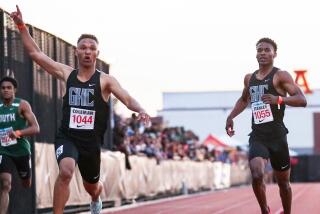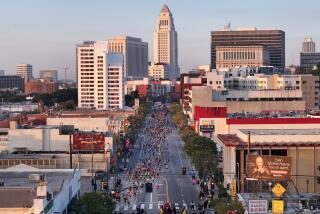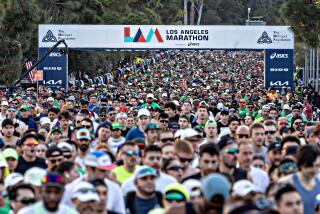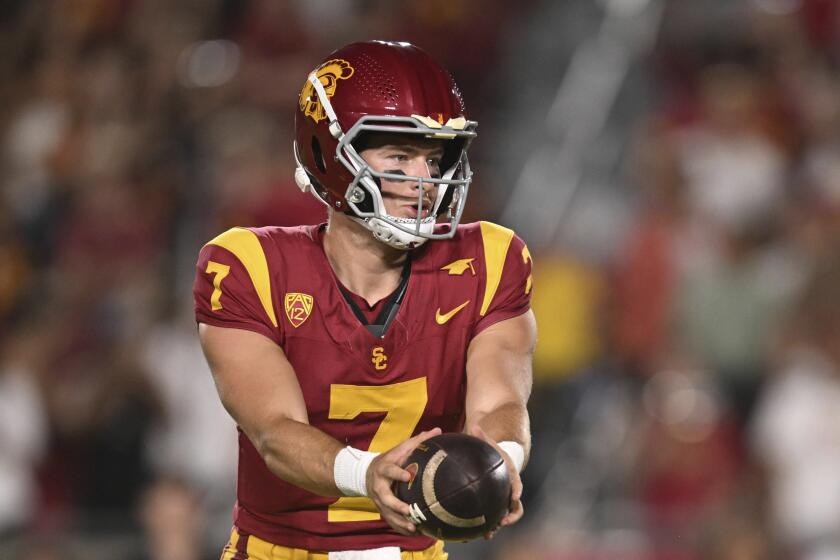Ultra runners view Western States’ hills and valleys as pinnacle of sport
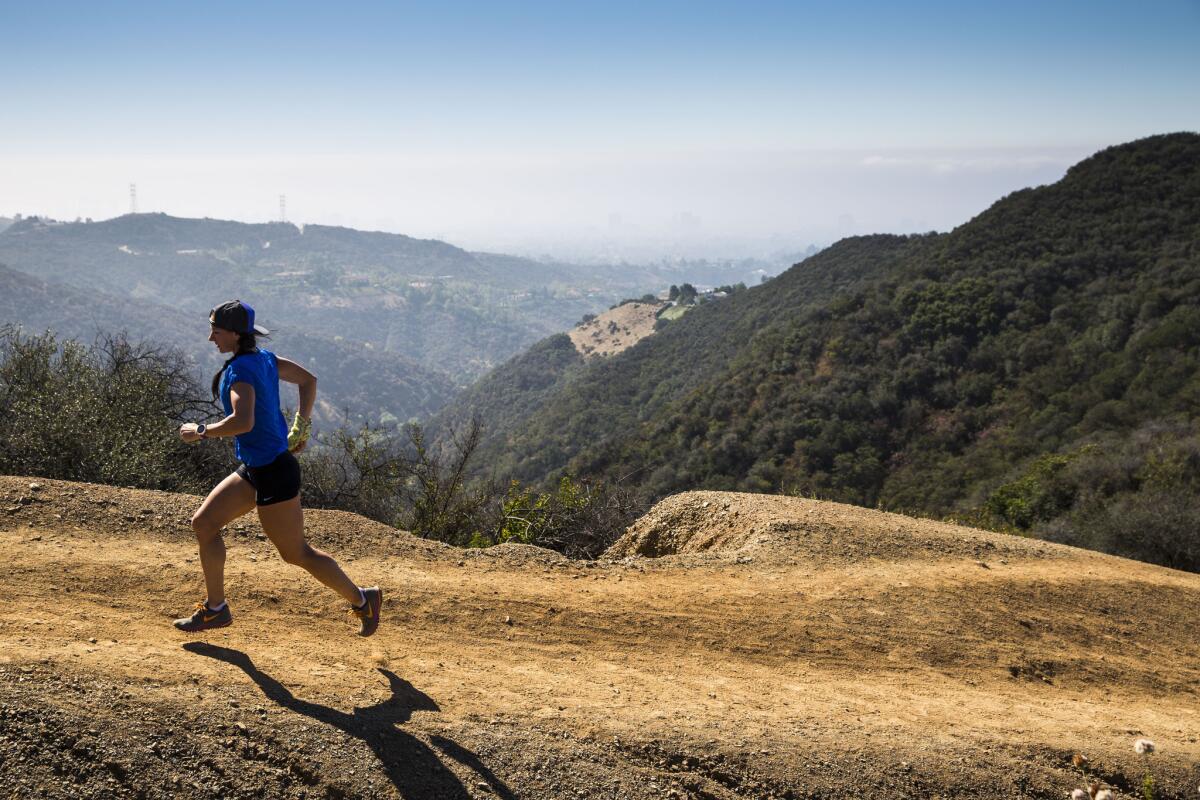
Sally McRae runs the Westridge Trail as she prepares for the 100-mile Western States Endurance Run.
It was 2:30 on a Saturday afternoon, and Sally McRae had been running for 9 1/2 hours.
She was tired and sweaty, as the 90-degree heat could not remove the moisture from her body fast enough. The climb out of a canyon deep in the Sierra Nevada was made even more difficult because she had injured her knee a few miles back.
McRae was 45 miles into the Western States Endurance Run, the world’s oldest 100-mile foot race. Veterans of the race say it takes as much of a mental toll as a physical one. At that point last summer, the 36-year-old was experiencing both.
If McRae had decided she couldn’t go on, she would not have been alone. Last year, of the 376 runners that started the race in Squaw Valley, 81 did not finish.
Those who make it to the end in Auburn, Calif., receive no prize money. If they make the top 10 or finish in fewer than 24 hours, they receive a silver belt buckle. If they do it in less than 30 hours, they get a bronze buckle. Any longer, and they drive home with nothing.
After 100 miles, having the race end is all most runners care about. They want to sit, eat, shower, and above all, do it very slowly. They cross the finish line, wobbly-legged and dehydrated, and slump in camp chairs or are carried to medical tents by friends and volunteers.
In recent years, ultra running — any distance beyond the 26.2 miles of a marathon — has become much more popular. More than 800 races took place in 2014, double from 10 years ago, and the number of finishers went from 25,000 to 70,000. Western States is considered the race that started it all.
More than 4,000 runners applied for this year’s race, which takes place Saturday. But the U.S. Forest Service, which oversees the land used for the course, limits the racers to fewer than 400 each year. For the last 14 races, a lottery has been used to pick the runners.
“It’s the Boston Marathon of ultra running,” says Dominic Grossman, who finished 19th last year.
The origin of the race is legendary among the ultra running community.
In 1974, Gordy Ainsleigh, a chiropractor from Meadow Vista, Calif., stepped to the line of the Tevis Cup, a 100-mile horse race through the Sierra Nevada.
Ainsleigh had finished twice, but in 1973 his mount pulled up lame halfway through the race. The next year, he decided to run, not ride, the distance. No one thought he would make it.
Ainsleigh’s name does not appear in the official results that year, but he did finish under the 24-hour time limit set for the horses. As a prize, he received the silver belt buckle that would later also become the trophy for the Western States run.
The next two years, a few others tried to replicate Ainsleigh’s feat, and then, in 1977, 14 runners split off from the Tevis Cup and officially started the foot race. The race’s history, small field and challenging terrain make it the pinnacle for ultra runners.
McRae never considered quitting last year. Like the other 295 finishers, she trained with these low moments in mind and developed a mind-set to overcome them.
“Climbing mountains, I think of that as just the challenges we face in life,” McRae said. “And you can either face them and become a stronger, better person because of them, or we can turn away. It’s the same thing on trails.”
Veterans of the race say these moments of self-doubt are unavoidable, but they can be overcome.
“The one thing I’ve learned doing 100-mile races is that if you just stick with it and keep moving forward, that ultimately you will get out of those lows and you will get back to where you feel better,” says Will Cooper, who has run the race three times.
Cooper recalls being energized when he heard a song by the Doors blasting from an aid station on the trail. “The moonlight above me, the Doors echoing across the canyon,” he said, “and you’re just kind of cruising along.”
The canyons, notorious for their punishing terrain, form the middle part of the race, where McRae injured her knee. As she pushed past mile 70 and along the nearly 23,000-foot descent, she began to gain ground, moving from 17th place among women to 11th.
In the last 22 miles, McRae ran faster than any other female outside the top three finishers.
The race ends on the track at Placer High, where hundreds of supporters stay throughout the night and into the morning to cheer on each runner. By the time McRae got there, she was 10th.
“People dream for so long of just getting into the Western States race, just in and of itself,” she says, “but running on that track....”
“I just remember seeing the lights from the track, and my heart was so overjoyed. It’s realizing this dream is coming true.”
It was 2:43 on a Sunday morning. McRae forgot about the pain in her knee as she jogged the last 50 yards. She leaped across the finish line with a sweeping smile as her friends and family surrounded her, hugging, laughing and crying. A race official gave her the silver buckle.
Then she sat down, and the pain in her knee came roaring back. Exhaustion overwhelmed her, and her joints and muscles ached and seized.
“Whether you break the course record or you come in last, you’re honored to have done it and survived, and you feel that commonality,” Grossman said. “Because no one really conquers the race. The leader is just happy to not get caught, and the last-place runner is just happy to not get caught by the time cutoff.”
McRae will be back on the starting line for Saturday’s race by virtue of finishing in the top 10 the previous year. She will experience pain, doubt and weariness, just as she did last year. But she will still savor her time on the trail.
“Anything that you’re passionate about, you learn something about yourself when you do it, whether it’s baking or basket weaving, writing, even being a parent,” McRae said. “Things are revealed about yourself, and it allows you to grow into a better person, and trail running has definitely done that for me.”
Twitter: @GregHadley9
More to Read
Get our high school sports newsletter
Prep Rally is devoted to the SoCal high school sports experience, bringing you scores, stories and a behind-the-scenes look at what makes prep sports so popular.
You may occasionally receive promotional content from the Los Angeles Times.
